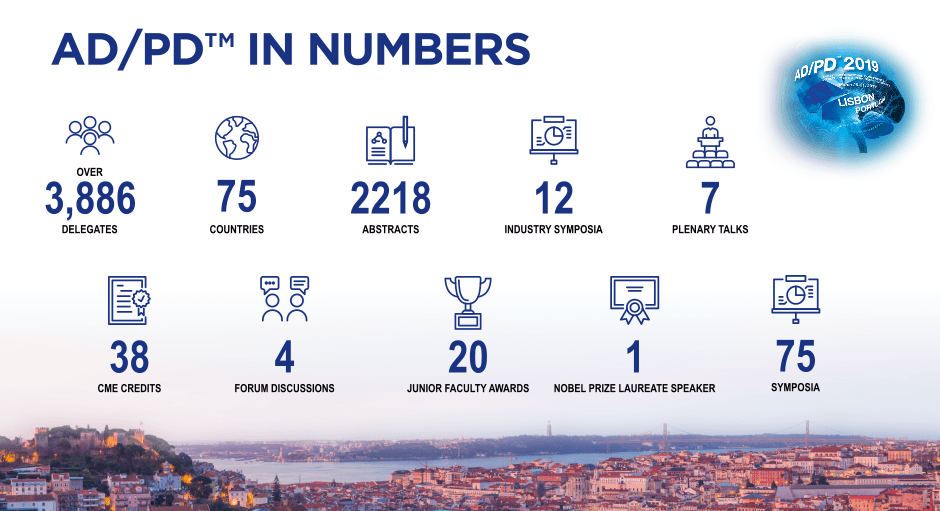Past Event Statistics
AD/PD™ 2019 STATISTICS
Cure in Mind, Cure in Sight – Bridging Eye and Brain Research
ALZFORUM CONFERENCE COVERAGE SERIES
“Held in romantically beautiful Lisbon, this AD/PD was the biggest thus far, drawing 3,982 attendees from 73 countries”
At AD/PD Conference, New Alzheimer’s Genes Reinforce Known Pathways
“After years of grunt work on next-gen sequencing and expression analysis, geneticists are finally reaping results. The new genes underscore the role of known pathways and cell types in disease.”
Expression, Expression, Expression—Time to Get on Board with eQTLs
“A tool of modern genetics, expression studies link GWAS hits to specific cell types, providing clues to pathogenesis. Microglia come up again and again.”
APP Upp: Mutation Nixes Six Amino Acids from Aβ, Spurs Aggregation
“Presented at AD/PD, the discovery by scientists in Uppsala is the first APP deletion found to cause Alzheimer’s disease. The same group found the Swedish and Arctic APP mutations.”
Parsing How Alzheimer’s Genetic Risk Works Through Microglia
“Scientists at AD/PD 2019 see a Goldilocks of microglial activation: Both too little and too much is bad in an injured brain. How could a therapy make it just right?”
Could CD33 Be the Microglial Target for Stimulating Phagocytosis?
“Inhibiting the receptor activates microglia to mop up debris, making CD33 an attractive therapeutic target.”
Could Greasing the Wheels of Lipid Processing Treat Alzheimer’s?
“Speakers at AD/PD 2019 reported that AD risk factors mess up lipid metabolism in glial cells. In cellular models, speeding the clearance of fats lessened pathology.”
Chimeric Mice: Can They Model Human Microglial Responses?
“By slipping human microglia inside the mouse brain, researchers hope to better monitor their response to pathologies, such as Aβ.”
Spitting, Sniffing: Is This How We Will Dx Parkinson’s?
“Scientists are probing saliva and skin secretions for telltale signs of Parkinson’s disease. Their prize? A diagnostic test at the pre-motor stage.”
ARIAS: Zooming in On Eye-based Biomarkers for Alzheimer’s
“Scientists know that the retina changes in people with preclinical AD; alas, there is neither consensus nor convergence in the field of retinal imaging. An upcoming initiative aims to determine which measures are most robust.”
On The Docket at AD/PD: The Many Crimes of ApoE4
“Microglia cleanup, mitophagy, axonal plasticity, blood-brain barrier. A renewed focus on ApoE4 is revealing new ways in which this isoform renders the brain vulnerable to Alzheimer’s.”
Off-Balance Endocytosis Lays Groundwork for Disease
“By aging cultured neurons and manipulating them to stimulate endocytosis or interfere with vesicle release, researchers can bring about characteristics of Alzheimer’s—without adding APP or Aβ.”
Antibodies Against Microglial Receptors TREM2 and CD33 Head to Trials
“As data increasingly blame the microglia response as a driving force in Alzheimer’s disease, researchers are investigating whether tempering these cells will aid cognition.”
Do Immune Cells Promote the Spread of α-Synuclein Pathology?
“At AD/PD 2019, scientists implicated both peripheral and central innate immunity in promoting propagation.”
Forget Fibrils: Lewy Pathology Is More Lipid Than Protein
“An electron microscopy study reveals a jumbled mess of membrane chunks and malfunctioning organelles, bound together by phosphorylated or truncated α-synuclein.”
Keep Your Enthusiasm? Scientists Process Brutal Trial Data
“We are learning” was the tenor of debate about the latest round of setbacks for anti-amyloid trials in symptomatic Alzheimer’s disease at a recent conference in Lisbon.”
BACE Inhibitors: Postmortem on One, Live Updates on Two
“Lanabecestat, elenbecestat, and umibecestat all showed data at the AD/PD conference in Lisbon. Learn what definitely doesn’t work and what might yet.”
Human Microglia Make Themselves at Home in Mouse Brain
“Analysis of a chimeric mouse shows that the cells express the same genes they do in the human brain, survey their environment, and respond to injuries and amyloid.”
Contact us now for pricing, bookings and customized packages.


